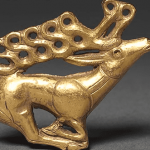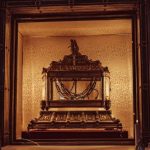 History
History  History
History  Pop Culture
Pop Culture 10 Cases of Grabbing Defeat from the Jaws of Victory
 History
History 10 Common Misconceptions About the Renaissance
 Weird Stuff
Weird Stuff 10 Crazy Things Resulting from Hidden Contract Provisions
 Facts
Facts 10 Unusual Facts About Calories
 Weird Stuff
Weird Stuff 10 Days of Humiliation When the Person Should Have Stayed in Bed
 Humans
Humans 10 Surprising Ways Game Theory Rules Your Daily Life
 Food
Food 10 Popular (and Weird) Ancient Foods
 Animals
Animals Ten Bizarre Creatures from Beneath the Waves
 Technology
Technology 10 Unexpected Things Scientists Made Using DNA
 History
History 10 Events That Unexpectedly Changed American Life
 Pop Culture
Pop Culture 10 Cases of Grabbing Defeat from the Jaws of Victory
 History
History 10 Common Misconceptions About the Renaissance
Who's Behind Listverse?

Jamie Frater
Head Editor
Jamie founded Listverse due to an insatiable desire to share fascinating, obscure, and bizarre facts. He has been a guest speaker on numerous national radio and television stations and is a five time published author.
More About Us Weird Stuff
Weird Stuff 10 Crazy Things Resulting from Hidden Contract Provisions
 Facts
Facts 10 Unusual Facts About Calories
 Weird Stuff
Weird Stuff 10 Days of Humiliation When the Person Should Have Stayed in Bed
 Humans
Humans 10 Surprising Ways Game Theory Rules Your Daily Life
 Food
Food 10 Popular (and Weird) Ancient Foods
 Animals
Animals Ten Bizarre Creatures from Beneath the Waves
 Technology
Technology 10 Unexpected Things Scientists Made Using DNA
10 “Ancient Alien” Artifacts That Have Mundane Explanations
Many relics of human history are so mysterious and wondrous that the imagination, at times, is tempted to run away from the seemingly commonplace and rather unimpressive explanations mainstream archaeology offers. Pseudo-archaeology instead makes more dramatic and appealing solutions, which are nevertheless based more on the need to believe rather than on rigorous scientific investigation.
One branch of pseudo-archaeology that fascinates many is the “ancient alien theory,” popularized in works by Erich von Daniken, which seeks to reinterpret the past in terms of primitive humans having alleged contact with extraterrestrial visitors in the dim past. The trouble with this approach is that it starts with a conclusion (“aliens did it!”) and interprets evidence to support that conclusion, the opposite of the real scientific method, which allows the evidence to speak for itself.
Many monumental works have been attributed to extraterrestrial intervention: the Pyramids, the Nazca lines, Stonehenge, Easter Island heads, and Baalbek, among many others. Our ancestors were not dimwits. They were as creative and intelligent as modern humans, perfectly capable of executing these structures. Genuine archaeologists acknowledge this and give them tribute. Ancient alien theorists would rather honor non-existent beings born out of their own fantasies while denigrating the achievements of their fellow humans.
In cases of smaller artifacts, they are led astray by mistaken identification, pareidolia, ignorance of the cultural context, and, worse, being completely bamboozled by fakes. This list will go through these in more detail.
Related: Ten Mysterious Historical Questions We Still Can’t Answer
10 Coso Artifact
One February day in 1961, three amateur geologists stumbled upon what they took to be a geode in the Coso Mountains near Olancha, California. When broken open, it revealed a porcelain-like cylinder with a shaft of metal in the center enclosed by a hexagonal sheath of copper and an unidentified substance. It appeared to be a piece of corroded metal with threads, obviously a manufactured object. But the geode it came in had fossils at least 500,000 years old, far older than the dawn of human history and civilized society.
UFO enthusiasts immediately pounced on it as part of an ancient alien spacecraft, others as evidence of visitation by time travelers. Creationists touted it as proof of a young earth. The artifact itself has now disappeared; all that remains for investigators are X-rays taken by a creationist “scientist.” When these X-rays were shown to spark plug collectors, they were unanimous: the Coso Artifact was a spark plug. More specifically, a spark plug from a 1920 Model T Ford.
How did it get encased in a 500,000-year-old geode? In the first place, the rock’s description given by one of the discoverers did not fit that of a geode. She referred to it as “hardened clay” (by contrast, geodes have a thin outer shell of dense chalcedonic silica and are filled with quartz crystals). She noted that other objects, including a nail and a washer, had attached to it. It is easy to see how 500,000-year-old fossils might similarly get trapped.
The Coso Mountains saw mining operations in the 1920s, and workers used Ford Model T trucks. For all the excitement and speculations, the Coso Artifact was just a used spark plug some mechanic threw away as trash.[1]
9 Baigong Pipes
In 1996, Chinese writer/archaeologist Bai Yu was exploring inside a cave in remote Mount Baigong when he saw what appeared to be an array of metal pipes coming out of the floor and walls. There were similar pipes along the surface of the hill and the nearby lake.
The samples Bai took to a government laboratory were discovered to be composed of ferric oxide, silicon dioxide, and calcium oxide, but 8% was of an unknown substance. The silicon dioxide and calcium oxide were the result of a long process of interaction between the iron and the surrounding sandstone. Scientists estimated the pipes to be 150,000 years old.
Ancient alien theorists were understandably enthusiastic about the sensational findings. Sometime before the arrival of Homo sapiens, extraterrestrial visitors were flushing away their poop in the mountains of China! Local authorities immediately seized the opportunity and erected signs of the “alien structures” to draw in tourists.
Scientists have observed, however, that the pipes bear a similarity to structures found in Louisiana and elsewhere. Geologists have determined that these were fossilized tree roots, as one study explains: “The cylinders are inferred to be tap-root casts of fossil trees in which sediments replaced wood, and pedologic and diagenetic processes caused the external form of the tree root to be preserved while the internal structure was lost.” The Baigong pipes may be the result of a similar process. Or they may once have been fissures in the sandstone created by the uplift of the Tibetan Plateau, which was then filled in by iron-rich sediments deposited by floods.
In either scenario, natural geological forces, not extraterrestrials, created the Baigong pipes.[2]
8 Abydos Helicopter
In the temple of Seti I at Abydos are hieroglyphs that appear to show modern machines—a helicopter, submarine, tank, and aircraft. How did ancient Egyptians know of such sophisticated technology? From aliens, of course. But only if the hieroglyphs actually depict what ancient astronaut theorists think they depict.
The “helicopter” hieroglyph is a case of “pareidolia,” the tendency of the brain to make out patterns and see something that is not really there, like the face of Jesus on a piece of toast. In ancient Egypt, it was customary to re-carve and update hieroglyphs when a new pharaoh took the throne. Digital imaging has revealed that this particular frieze originally read, “He who repulses the nine enemies of Egypt,” in reference to Seti I (circa 1294–1279 BC). Upon the accession of Rameses II (circa 1279–1213 BC), this was covered in plaster, and the new inscription was carved: “He who protects Egypt and overthrows foreign countries.”
As the plaster eroded over time, the two images combined into one, which took on the appearance of a helicopter.[3]
7 Dendera Light
Another controversial ancient Egyptian relief can be found in the temple complex of Dendera, where two figures are holding what appear to be Crookes tubes, vacuum-sealed containers that carry electricity. Ancient alien theorists believe they had discovered how Egyptians illuminated the darkened labyrinths of their temples, which purportedly show no evidence of soot from torches (spoiler alert: they do—layers of it).
Ignorance of Egyptian religious symbolism and motifs is largely responsible for misidentifying this relief, which shows the creation of the world as pictures of electrical devices. The lotus flower was believed by the Egyptians to be the first thing to come out of the sea of nothingness at the beginning of time, probably because it closes at night and reemerges during the day. From the lotus sprang the god Atum (later merged with the sun god Ra), who created everything else. In the Dendera relief, we see Atum, represented as a snake, coming out of the lotus flower. It is certainly not the filament of a light bulb we are looking at.
And that is not a glass bulb encasing the filament; it is the universe represented by a bubble of air emerging from Atum. The figure with the upraised arm is the goddess Nun, the primordial waters supporting the lotus flower, Atum, and the universe. Nun is depicted in a similar pose in other reliefs, corroborating the mainstream interpretation.[4]
6 Baghdad Battery
In the 1930s, a peculiar artifact was discovered in the Iraqi capital of Baghdad by archaeologist Wilhelm König. It was a small clay pot with the top missing. Inside was a copper cylinder encased by an iron rod, which protruded through the asphalt-sealed lid. König noted that the two metals, if combined with an electrolyte, are the main components of a battery. Evidence that the jar once held an ionic solution, probably vinegar or wine, led König to the fantastic conclusion that the jar might have been an ancient battery.
The jar was dated initially to the Parthian era (250 BC–225 AD). Still, more recent investigations determined it to be from the Sassanid period (AD 250–650). König speculated that it might have been used for electroplating, but no electroplated objects from that time have ever been found, nor any trace of wires that must have been necessary to connect the battery to anything. Experiments did show that with the necessary solution, the jar could indeed yield a volt of power, but this was far too weak to be of significant use. It is also strange that no contemporary or later text mentions the device, something we would have expected for such a marvel.
Contrary to those who regard the battery as evidence of higher technology from ancient times, possibly gained from alien contact, no archaeologist thinks this artifact was indeed a battery. It looked very much like the other clay jars being dug up in the region, jars used to store papyrus scrolls. The papyrus would have been wound around the metal rod before being slid inside the container. Papyrus and parchment are acidic, and the acidic residue in the jar, far from being a battery electrolyte, more likely came from decomposed papyrus.[5]
5 Iron Pillar of Delhi
Among the ruins of the Qutb temple complex in Delhi, India, stands a 1,600-year-old pillar of iron that bears no traces of rust or corrosion. Built around the time of King Chandragupta II (reigned AD 375–415), the pillar is 24 feet (7.3 meters) tall and 16.4 inches (41.6 cm) in diameter, tapering to around 12 inches (30.5 cm) at the top, where an ornamental structure sits.
In 1333, the explorer Ibn Battuta wrote: “One of their learned men told me that it is called ‘Haft Jûsh,’ which means ‘seven metals,’ and that it is composed of these seven. A part of this column, of a finger’s length, has been polished, and this polished part gives out a brilliant gleam. Iron makes no impression on it.”
So, is this pillar another extraterrestrial gift to humanity? Researchers have discovered that a thin layer of “misawite,” a compound of iron, oxygen, and hydrogen, has protected the cast iron pillar from rust. This layer was formed by the high phosphorous content of the iron, one percent, against the .05% content of modern iron. The unique iron-making process used by ancient Indians turned iron ore into steel in one step by mixing it with charcoal, resulting in a higher phosphorous content than today’s steel. In contrast, the modern method uses limestone, which produces steel from molten slag and pig iron. The slag carries away most of the phosphorus.
Rather than an extraterrestrial artifact, the iron pillar of Delhi is an example of ancient Indian metallurgical and engineering skill.[6]
4 Piri Reis Map
In 1513, Ottoman Turkish navigator and cartographer Hajji Ahmed Muhiddin Piri (called “Reis,” Turkish for admiral) compiled a remarkably detailed map that seems to show Antarctica, a continent no human had ever seen until 1820. Furthermore, the Antarctic region is depicted as being free of ice, something that last occurred 34 million years ago. How the mapmaker obtained this knowledge has long mystified scholars and historians. Was the map somehow drawing on memories of a survey done by orbiting alien spaceships in prehistoric times?
However, for a chart supposedly transmitted by aliens, the Piri Reis map is not so accurate. Understandably so, as Piri Reis himself enumerates the sources for his compilation: eight Ptolemaic maps, four Portuguese maps, one Arabic map, and one drawn by Christopher Columbus, all using only the available cartographic techniques of their time. Piri Reis’s Caribbean and North America are distorted and erroneous. Several islands are absent, but a mythical, non-existent one called Antillia is included.
This habit of drawing mythical lands into maps was quite common at the time. The Garden of Eden, El Dorado, and the fabled kingdom of Prester John appear in maps of the period. Here may lie the answer to the puzzle. The Piri Reis map does not show Antarctica at all, but the hypothesized Terra Australis Incognita (Unknown Southern Land), which people believed must exist beyond South America to “balance out” the continents of the Northern Hemisphere.
What the Piri Reis map proves is that the Ottoman Turks were on par with Europeans in navigational and cartographic skills.[7]
3 Quimbaya Airplanes
In the early 20th century, a hoard of 135 gold objects was discovered near the Magdalena River in Colombia, where a people called the Quimbaya flourished between 500 BC and AD 600. The funerary objects included small figurines of humans, birds, insects, and fish. Ten or so figures look eerily like airplanes with tails and delta wings. Ancient alien theorists confidently call them “fighter jets,” evidence that the Quimbaya knew the secret of powered flight, with help from aliens, of course.
If the rest of the collection depicts insects and fish, why shouldn’t we conclude that the so-called “fighter jets” are also representations of these animals? To the objection that they don’t look like anything in nature, it must be pointed out that these figurines are highly stylized, and the artist was not striving for realism. This is borne out by the other undisputed animal figurines, which were crafted in elaborate, exaggerated, and fanciful fashion. When ancient alien theorists built a scale model plane based on one of the figurines, they had to remove some features just to make it fly and “prove” their claim. Obviously, the original figurine is not as aerodynamic as they make it out to be. They succeeded in proving the opposite.
The few objects in question also have teeth and eyes. What else would they be but animals?[8]
2 Dogu Figurines
Admittedly, scholars are still puzzled as to exactly what Dogu figurines are and what purpose they serve. “Dogu” is Japanese for “earthen figure” and refers to the odd, humanoid clay sculptures ranging from 4 to 12 inches (10 to 30.5 cm) in height, dating from the Jomon Period of Japanese prehistory (40,000–400 BC). Dogu generally have bulging eyes that are out of proportion to the body, elongated heads, and strange, elaborate costumes. Did the ancient Japanese recreate a visiting astronaut in art, complete with a helmet, goggles, and spacesuit?
With their wide hips and breasts, Dogu were probably a representation of the pregnant female form, as they bear a resemblance to fertility figures created by other prehistoric cultures, such as those of Venus in Europe. They may have been used as aids to childbirth, in fertility, or in burial rituals. They may even be nothing more than toys. Just because they are wearing what appears to be a spacesuit doesn’t mean it is a spacesuit. The goggles, for instance, look very similar to those worn by the Inuit as protection from snow blindness. Whatever they were, the one thing archaeologists are sure they are not depicting is an ancient astronaut.[9]
1 Crystal Skulls
The Aztecs and Mayans were known to have a macabre fascination with human skulls. When the first crystal skulls began appearing in the 19th century, enthusiastic museums, including the Smithsonian and the British Museum, sought to acquire these masterpieces of Mesoamerican art. People have wondered how the pre-Columbian natives of Mexico carved the skulls with the detail and sophistication that could only be achieved by modern tools. Ancient alien theorists naturally have their stock answer — extraterrestrials.
The authenticity of the skulls began to be questioned in the 1930’s. One red flag was that none of the skulls were uncovered in an actual archaeological dig. Museums analyzed and investigated their skulls and indeed found them to be fakes, even pinpointing their place of manufacture in Germany. Records accompanying the artifacts turned up a suspect: Frenchman Eugene Boban, whose reputation as an expert in Mexican antiquities provided an impenetrable cover for his traffic in fake crystal skulls.
The case against Boban was convincing, and ancient alien enthusiasts were forced to concede. But they still insist that at least one crystal skull is genuine. It was allegedly discovered in 1924 by British adventurer Frederick Mitchell-Hedges and his daughter Anna in a Mayan pyramid in Belize. After her father’s death, Anna kept the skull but refused to have tests done on it. It was only in 2007, after Anna’s passing, that the Smithsonian investigated and found that it was also a fake like the others.
Ancient alien theorists are still holding their ground despite the contrary evidence. Rationality is no match to the need to believe.[10]








